| Article ID | Journal | Published Year | Pages | File Type |
|---|---|---|---|---|
| 6536866 | Agricultural and Forest Meteorology | 2018 | 9 Pages |
Abstract
Eddy covariance methodologies have greatly improved our understanding of the forest carbon cycle, including controls over year-to-year variability in productivity (measured as net ecosystem productivity, NEP, where NEP is the difference between the mass of carbon fixed by photosynthesis and that lost by ecosystem respiration). However, establishing and maintaining eddy covariance towers requires sizeable financial and logistical investments. Tree-ring methods, which can produce annual estimates of tree biomass increment from individual trees, provide an alternative approach for assessing forest productivity. Attempts to link these measures of productivity (i.e., NEP and tree biomass increment) have produced inconsistent results, in part because NEP time series are typically too short to provide robust comparisons. We here use a relatively long (20-year) NEP time series together with annual tree biomass increment (derived from tree-ring data) from the same site to determine to what extent the two productivity measures relate to each other. We conducted this study at the Howland Research Forest, central Maine USA, which supports a mature, mixed-species conifer forest. We expressed stand-level tree biomass increment on a per-area basis, which allowed direct comparisons with NEP data. Our results revealed a strong relationship between tree biomass increment and annual NEP measurements when the latter are summarized from previous-year fall to current-year fall, a marked improvement over more typical calendar-year summaries. Further, our results suggest tree biomass increment lagged one year behind NEP (i.e., assimilated carbon was not allocated to wood formation until the following year) for roughly the first half of the time-series, but later became synchronized with current-year NEP. This shift to synchrony may reflect a change in stand-level carbon allocation and growth dynamics. The apparent shift in carbon allocation from storage into current-year wood formation is most evident in two recent years with above-average spring temperatures. Although our results demonstrate a link between annual tree biomass increment and NEP, they also point to complexities that may confound our interpretation of these productivity measures.
Related Topics
Physical Sciences and Engineering
Earth and Planetary Sciences
Atmospheric Science
Authors
Aaron Teets, Shawn Fraver, David Y. Hollinger, Aaron R. Weiskittel, Robert S. Seymour, Andrew D. Richardson,
